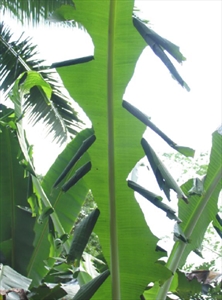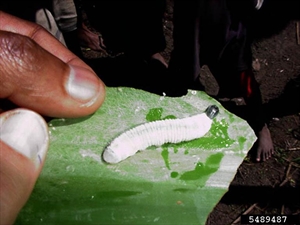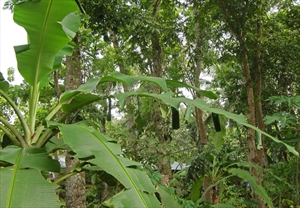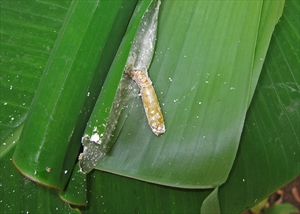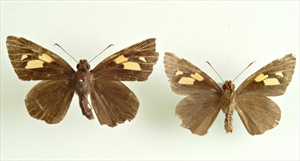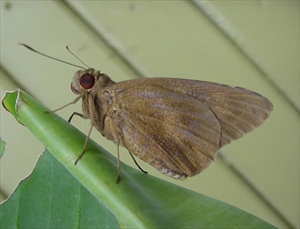Banana skipper, banana leaf roller, hesperiid butterfly
Pacific Pests, Pathogens, Weeds & Pesticides - Online edition
Pacific Pests, Pathogens, Weeds & Pesticides
Banana skipper (181)
Erionota thrax; there are three subspecies: Erionota thrax thrax in Papua New Guinea, Erionota thrax mindana in the Philippines, and Erionota thrax basdrubal in the northern Moluccas - the Moluccas are islands between East Timor, Sulawesi and Irian Jaya. Another very similar species Erionota torus -mostly separated on male genitalia - is present in South and Southeast Asia. It is a member of the Hesperiidae.
South and Southeast Asia, Oceania. The banana skipper is present in Guam, Hawaii, Northern Mariana Islands, and Papua New Guinea.
Banana and other Musa species, including Manila hemp (Musa textalis). It is also recorded on bamboo, coconut, oil palm and other palms.
The caterpillars do the damage by shredding the leaves and making numerous rolls of the leaf blade, up to 15 cm long, in order to feed safely inside them (Photo 1).
Eggs, 2 mm diameter, are laid singly or in groups of up to 25, mostly on the underside of banana leaves. The eggs hatch in 5-8 days. The caterpillars, which are pale green with a distinctive shiny black head (Photo 2), make their way to the edge of the leaf to feed and to make the characteristic rolls (Photo 3). If a caterpillar rolls the leaf near to the roll of another caterpillar it abandons the roll, and starts again on another part of the same leaf or makes its way to another leaf. There are five larval stages over 30 days. All except the first stage is covered in a white waxy powder; this and the fact that older caterpillars close their rolls more securely than younger ones, allows them to survive heavy rains. Caterpillars grow to 6 cm.
Pupation occurs inside the leaf roll, and takes about 10 days. The pupae, too, are covered in a white wax (Photo 4).
The adult male has a wingspan of 70-75 mm, and the female about 80 mm (Photos 5&6). The moth is brown with three yellow spots on the forewings.
The banana skipper butterfly spreads as eggs on leaves of banana plants used as planting material, and, possibly, longer distances in vehicles, boats and planes.
Damage of up to 60% of the leaf area of banana plants has been recorded during outbreaks. If the outbreak comes at the time of fruiting, yields are lower due to delayed fruit maturity and reduce bunch size. Pruning experiments have shown that a 50% defoliation at fruiting can result in nearly 30% loss in fruit weight. In an outbreak in Papua New Guinea in the late 1980s, 70% defoliation was recorded in some parts of the country, with up to six rolls per leaf; in some seasons defoliation was total.
Look for the distinctive leaf rolls, up to 15 cm long, made by the caterpillars. Look for caterpillars in the rolls that have shiny black heads and are covered in wax.
NATURAL ENEMIES
There are several parasitic wasps and flies that attack the banana skipper. Guam, Hawaii and Mauritius have introduced the egg parasite, Ooencyrtus erionotae, and the larval parasite Apanteles erionotae. Heavy rains also bring about death of the young caterpillars, and wind reduces populations by shredding the banana leaves so that the caterpillars cannot make their protective rolls.
In Guam, Apanteles erionotae was introduced, but not Ooencyrtus erionotae, which was found to be present and probably came in with the introduction of its host. In Hawaii, both these parasitoids were introduced to good effect. In Papua New Guinea, as in Guam, Ooencyrtus erionotae was found to be present and probably came in with parasitised eggs. Alone, it cannot prevent damage to bananas; however, before the larval parasitoid, Apanteles erionotae, can be introduced, its specificity needs to be established as there are native butterflies related to the banana skipper in Papua New Guinea.
CULTURAL CONTROL
- Handpick the leaf rolls containing the caterpillars.
- Collect eggs and caterpillars and place them in screened boxes close to banana plants with rolled leaves. The screen allows the parasites to escape.
CHEMICAL CONTROL
If pesticides are necessary, use botanical (plant-derived pesticides) sprays first, as these may cause less harm to natural enemies, and cost less than synthetic commercial products.
- Use neem, derris, pyrethrum or chilli (see Fact Sheets no. 56). If these are used, add soap to help the chemical reach the caterpillars within the rolled leaves.
- Alternatively, use commercial biopesticides, e.g., spinosad (the product is called Success) or Bt - Bacillus thuringiensis var. kurstaki.
- If using Bt, note the following:
- Ensure that Bt covers the plants: caterpillars will only die if they eat the Bt crystal proteins.
- Eggs are not susceptible to Bt.
- Bt should be used as soon as damage is seen.
- Small larvae are more susceptible to Bt than fully grown ones.
- Synthetic pyrethroids are likely to be effective, but will also kill natural enemies.
--------------------
Note, derris (Derris species) contains rotenone, an insecticide, often used as a fish poison; it should be used with caution. The commercial derris insecticide is made from Derris elliptica.
____________________
When using a pesticide, always wear protective clothing and follow the instructions on the product label, such as dosage, timing of application, and pre-harvest interval. Recommendations will vary with the crop and system of cultivation. Expert advice on the most appropriate pesticides to use should always be sought from local agricultural authorities.
AUTHOR Grahame Jackson
Information from Plant Health Australia (undated) Banana skipper butterfly. Queensland Government. (https://www.farmbiosecurity.com.au/wp-content/uploads/2019/03/Banana-skipper-butterfly-FS.pdf); Erionata thrax (2021) Wikipedia. (https://en.wikipedia.org/wiki/Erionota_thrax); Australian Banana Growers' Council (2019) Under the microscope: Banana slipper butterfly. (https://abgc.org.au/2019/08/22/under-the-microscope-banana-skipper-butterfly/); and Walker K (2005) Banana skipper (Erionota thrax): PaDIL - http://www.padil.gov.au; and from CABI (2020) Erionota thrax (banana skipper). Crop Protection Compendium. (https://www.cabi.org/cpc/datasheet/21833). Photo 1 Exotic pest alert: Banana skipper butterfly (NSW Department of Primary Industries (2014) Primefact, Plant Biosecurity, Orange. Photos 2,5&6 Pest and Disease Image Library, Bugwood.org. Photos 3&4 Richard Markham, ACIAR, Canberra.
Produced with support from the Australian Centre for International Agricultural Research under project PC/2010/090: Strengthening integrated crop management research in the Pacific Islands in support of sustainable intensification of high-value crop production, implemented by the University of Queensland and the Secretariat of the Pacific Community.
